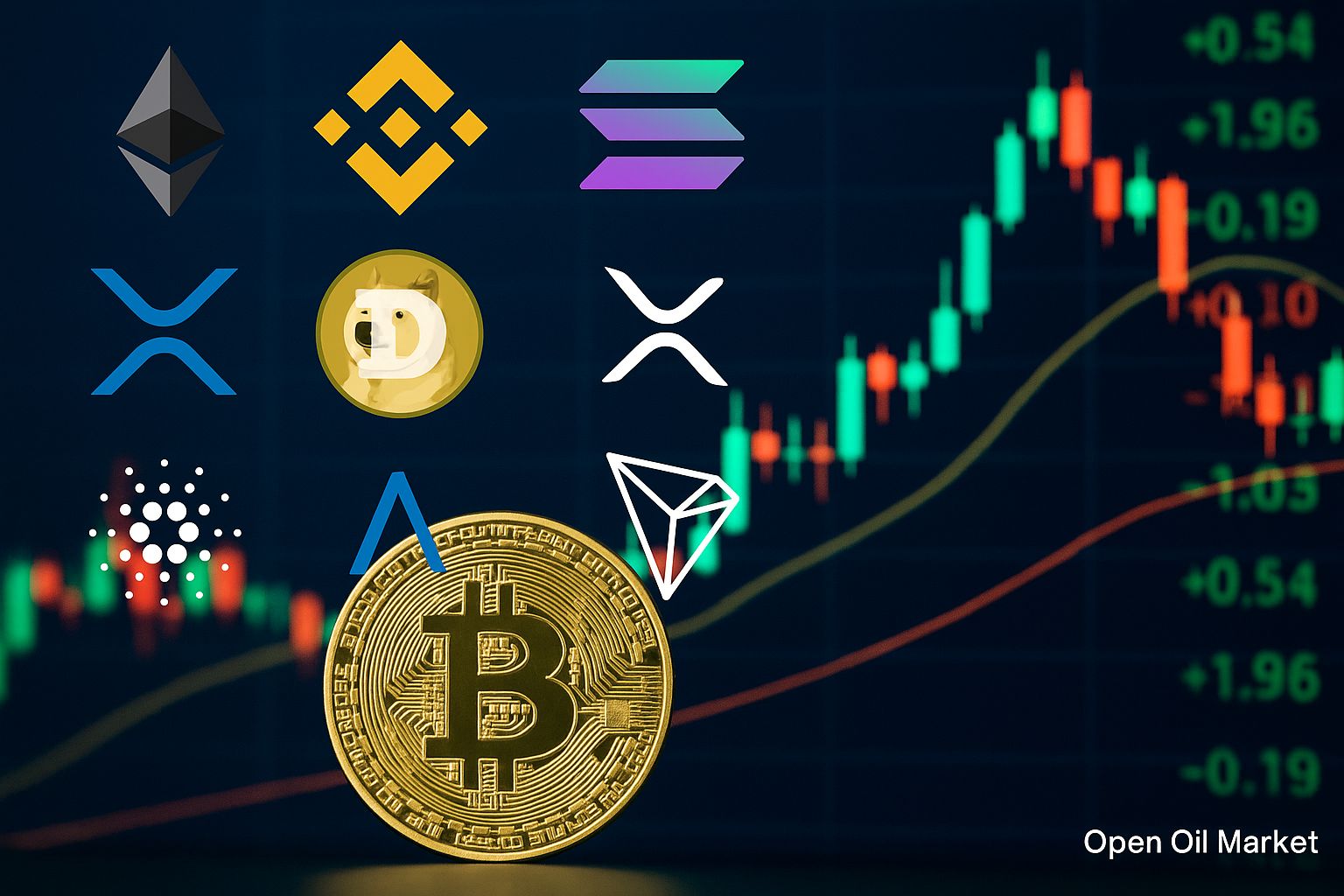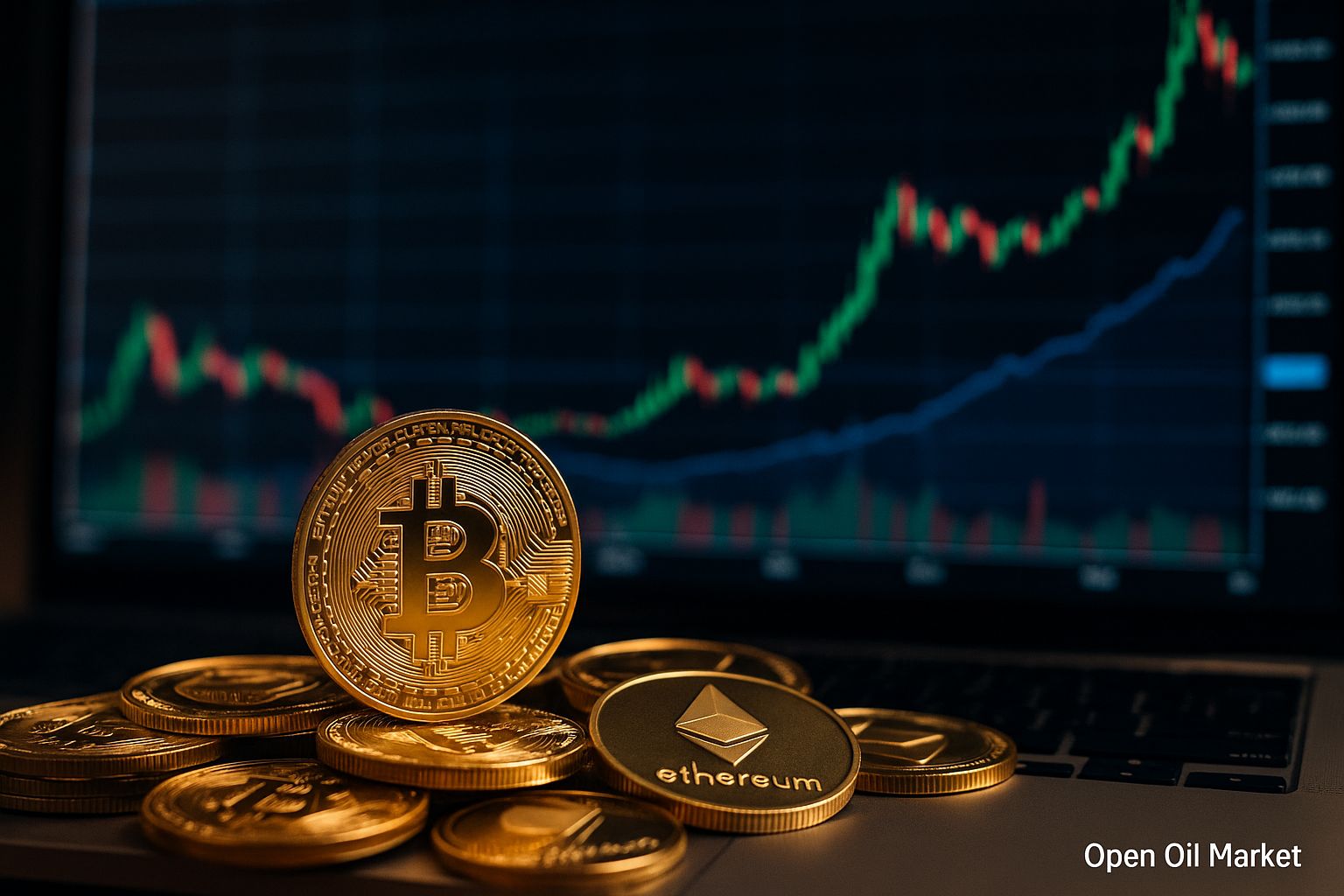
Current Cryptocurrency News as of 23 September 2025: Bitcoin Maintains Level Above $110,000, Ethereum Corrects, Altcoins Decline. Institutional Investments via ETFs Support the Market, Key Developments in DeFi, NFTs and Regulation.
Bitcoin: Market Corrects After Peak
The flagship cryptocurrency Bitcoin (BTC) is consolidating around $112,000 after a recent pullback. In August, BTC reached a historical high of over $124,000, but in recent days the market has experienced a wave of profit-taking and liquidations of margin positions. On Monday, the BTC price fell by approximately 3% to ~$111,000 before rebounding above $113,000 by the end of the day. Despite this correction, the current price remains merely a few percentage points below record peaks, with Bitcoin still showing a growth of around 20% year-to-date.
Analysts note that the recent decline is largely technical in nature. The liquidation of "overheated" long positions (with a total volume of about $1.5 billion) is considered a healthy cleansing of the market from excessive leverage. This reduces the risk of a sharp drop in the future and lays a more solid foundation for continued upward trends. At the same time, fundamental factors remain positive: after the spring halving, the supply of BTC is increasing at a slower rate, which, alongside sustained demand, supports prices. Major institutional players have taken advantage of the recent downturn for purchases; estimates suggest that about 6% of the total Bitcoin supply has already been accumulated through exchange-traded funds (ETFs). Maintaining BTC above the psychologically significant level of $110,000 instills confidence in investors and keeps the prospects for a return to new highs alive, should market conditions improve.
Ethereum: Correction After Growth
The second-largest cryptocurrency Ethereum (ETH) is also experiencing a pullback following impressive growth. Just a week ago, Ether surged near the $4,600 mark, establishing a new local high in recent years. However, a correction followed: Ethereum is currently trading around $4,200, approximately 6–7% below its daily peak. Over the past 24 hours, ETH has declined more sharply than Bitcoin (around -6%), partly due to profit-taking by investors who shifted towards the more stable BTC amid increased volatility.
Despite the short-term decline, Ethereum's mid-term outlook remains positive. First, the institutional interest is on the rise: last week, funds based on ETH attracted hundreds of millions of dollars, with total assets under Ethereum ETFs reaching nearly $30 billion (about 5.5% of ETH's market capitalisation). Second, the community is gearing up for an important network upgrade called "Fusaka," scheduled for December 2025. This hard fork aims to increase scalability and reduce fees on the Ethereum network, which is already attracting additional investor interest. Currently, ETH is holding above support around $4,100, with key resistance at the $4,500–$4,600 zone. A confident breakthrough above $4,500 could restore upward momentum, while a drop below $4,000 could exacerbate bearish sentiment in the short term.
Altcoins: Decline Among Most Leaders
The broader altcoin market is largely mirroring the dynamics of the leaders, exhibiting a decline amid the overall correction. Among the top 10 cryptocurrencies by market capitalisation, nine have taken a hit in the past 24 hours. Notably significant losses are observed among meme cryptocurrencies: Dogecoin (DOGE) has dropped approximately 10% to $0.24, becoming one of the day's major underperformers. A substantial downturn is also seen with Solana (SOL), which has lost about 7%, sliding to ~$220. XRP (the token of Ripple) has fallen below the psychological level of $3 after a recent rally, with the coin declining about 4% over the day, trading around $2.85. However, XRP still remains significantly above the levels from the beginning of the year, largely due to Ripple's legal victory over the SEC in July, which lifted some regulatory restrictions on the token.
Among leading altcoins, Binance Coin (BNB) stands out, as despite a daily decline (~ -4%), it remains the only one in the top five that has shown growth over the week (+11% over the last 7 days). BNB is trading around $1,000, demonstrating relative resilience amid news about the expansion of the Binance ecosystem and the launch of its own tokens. Tron (TRX) also appears relatively stable, having dipped less than 1% over the day (to ~$0.35) due to a steady influx of transactions within its blockchain network. Cardano (ADA) holds around $0.82 after a minor decline (-1–2%), reflecting cautious optimism from investors regarding the continued development of its platform. Stablecoins Tether (USDT) and USD Coin (USDC) continue to remain pegged to $1, providing crucial liquidity to the market even during periods of heightened volatility.
Institutional Investments and Crypto-ETFs
Despite the price correction, interest from major investors in cryptocurrencies continues to grow. In the past week, following the first interest rate cut by the US Federal Reserve in 2023, the inflow of funds into digital assets has significantly accelerated. According to CoinShares, approximately $1.9 billion flowed into cryptocurrency-based investment products last week – the second consecutive weekly increase, elevating total assets under management to a record $40 billion. Primarily, institutions have been investing in Bitcoin funds, which attracted nearly $1 billion in new capital, while Ethereum funds also received a substantial $772 million. This influx of capital has led to an increase in open positions and helped the market partially recover from a dip at the end of last week.
Particular attention should be paid to the boom of crypto ETFs. US regulators are expediting the approval of new products: in September, the Securities and Exchange Commission (SEC) approved streamlined listing rules for spot crypto ETFs, reducing the review period for applications from 240 to 75 days. As a result, several issuers rushed to submit new applications – now, there are over 90 different crypto ETFs in the queue, including funds for Solana, XRP, and even meme tokens (such as Bonk and Dogecoin). The market has already seen the launch of the first spot ETFs in US history for certain altcoins: trading commenced on the Cboe exchange for Dogecoin (ticker DOJE) and XRP (ticker XRPR). On the very first day, these funds attracted millions of dollars, indicating a high demand from investors seeking to access altcoins through familiar exchange instruments.
The Bitcoin ETF from BlackRock (iShares Bitcoin Trust, ticker IBIT) remains the market leader. As of 19 September, within a single day, this fund attracted over $246 million in new investments, while the total net inflow to all US Bitcoin ETFs exceeded $220 million. As a result, more than $150 billion (approximately 6.6% of Bitcoin's total market capitalisation) is now managed under BTC spot ETFs. The emergence of such volumes of traditional capital in the crypto market has become one of the key factors for growth in 2025 and continues to uphold trust in digital assets, even during correction periods.
Regulation and Macroeconomic Factors
Global politics and economics continue to exert a significant influence on the crypto market. Recently, investors reacted with concern to an unexpected political decision in the US: President Donald Trump's administration proposed imposing a $100,000 fee for H-1B work visas. This initiative strikes at the technology sector (especially Indian IT companies) and heightens uncertainty in the markets. Concerns about potential trade frictions and increased business costs temporarily reduced risk appetite – some capital flowed into safe assets (the US dollar, government bonds), which indirectly pressure cryptocurrencies. Experts warn that volatility in digital assets may remain elevated until there is clarity regarding the fate of this proposal and the reactions from major IT corporations.
On the other hand, monetary policy is now playing in favour of the crypto market. The Federal Reserve, on 17 September, lowered the base interest rate for the first time in a long while (to 4.25%), signalling a softening of monetary policy. Although the accompanying comments from the Fed were cautious (which prevented the market from embarking on a confident upward trajectory immediately), the very trend towards lower rates supports prices on risk assets. The long-awaited easing of monetary policy, along with more lenient industry regulation under the current US administration, has become one of the drivers of the crypto rally in the first half of 2025. Progress is also observed in regulatory matters in Europe: the implementation of MiCA regulations provides clearer rules for crypto companies within the EU, enhancing the market's attractiveness in the eyes of investors.
In Asia, authorities are taking a mixed stance. In China, regulators have recommended that Hong Kong brokers suspend operations related to the tokenisation of real-world assets (RWA), showing caution in the development of new crypto products. Nevertheless, overall Asian markets remain interested in digital assets: for instance, Japan and Singapore continue to implement blockchain solutions with government support. Thus, globally, regulators are striving to find a balance between innovation and risk control, and news on this front can swiftly influence market participants' sentiments.
Market Indicators and Sentiment
Despite the price decline, market sentiment in the crypto sector remains cautiously neutral. The cryptocurrency "fear and greed" index has only dropped to 47 points, corresponding to a neutral level (last week's measure was 51). This indicates that investors are neither panicking nor displaying excessive enthusiasm – the market is waiting for clear signals. Daily trading volume across the entire market has risen to $190 billion, reflecting increased activity: some traders rushed to sell during the downturn, while others saw an opportunity to buy during the dip.
Historical statistics indicate that September has traditionally been a challenging month for cryptocurrencies: over the last 10 years, Bitcoin has averaged a loss of around 3–4% during this month. Nevertheless, ahead lies October, which crypto enthusiasts have dubbed "Uptober" for its tendency towards growth. Bitcoin has closed positively in 10 of the last 12 Octobers, and many market participants are hopeful for a repeat of this positive seasonality. If the macroeconomic backdrop proves favourable (for instance, with slowing inflation and further rate cuts), Bitcoin could well regain lost positions and aim for new heights by the end of October. However, analysts emphasise that there are no guarantees: the continued high level of uncertainty (from Fed actions to geopolitical issues) may continue to restrict growth. In the coming days, investors will closely monitor speeches from US Fed representatives and fresh inflation data (the PCE index will be released on Friday) – these events could set the tone for market dynamics at the start of the fourth quarter.
Top 10 Most Popular Cryptocurrencies (as of 23.09.2025)
- Bitcoin (BTC) – approximately $112,000; daily change -2.7%. Bitcoin remains the largest cryptocurrency with a ~58% share of the overall market capitalisation. Despite current corrections, BTC is still slightly positive over the last week (+2%) and has significantly risen year-to-date. Institutional demand and its status as "digital gold" support its price.
- Ethereum (ETH) – approximately $4,200; daily decline ~6.7%. Ether maintains second place in capitalisation, showing high volatility. Following a summer rally and new highs above $4,500, ETH is pulling back, but the anticipated network upgrade and the growth of the DeFi sector continues to attract investors.
- Ripple (XRP) – ~$2.85; daily drop ~4%. XRP recently surpassed $3 for the first time since 2018, bolstered by positive news regarding Ripple's legal victory over the regulator. The current pullback has not hindered XRP from entering the top three largest crypto assets, with interest supported by plans to use XRP in bank settlements and the launch of an ETF on this token.
- Tether (USDT) – $1.00; change 0%. The largest stablecoin is pegged to the US dollar and serves as a primary means of hedging and settlement in the crypto market. The market capitalisation of USDT stands at about $170 billion, reflecting substantial demand for stable digital assets for trading and value preservation.
- Binance Coin (BNB) – ~$1,000; daily change -3–4%. The Binance ecosystem’s coin has grown at a double-digit rate over the week, although it has corrected in the last 24 hours. BNB is strengthening amid the expansion of Binance's services and token burns, maintaining its position among the top five largest cryptocurrencies.
- Solana (SOL) – ~$220; daily decline ~7%. The fast blockchain platform Solana remains among the leaders, although its token is volatile. SOL has significantly recovered in 2025 due to improved network scalability and an increase in projects within its ecosystem, but current pullbacks illustrate its sensitivity to market sentiment.
- USD Coin (USDC) – $1.00; change 0%. The second-largest stablecoin, fully backed by dollar reserves. With a capitalisation of about $74 billion, USDC is widely used by institutional participants and DeFi protocols, providing liquidity and stability in market settlements.
- Dogecoin (DOGE) – ~$0.24; daily change -10%. The popular meme token experiences sharp price fluctuations. After impressive growth at the beginning of the year, DOGE has pulled back amid profit-taking. However, community interest and the launch of futures/ETFs on Dogecoin maintain attention on this coin, known for its high speculative potential.
- Tron (TRX) – ~$0.35; daily change around -0.4%. The Tron blockchain focuses on entertainment and decentralized applications, providing high transaction throughput. TRX demonstrates relative stability due to ongoing network use (for example, for stablecoins USDT) and engagement from Asia in the project.
- Cardano (ADA) – ~$0.82; daily decline ~1%. The Cardano platform maintains its place in the top ten, steadily developing its technology (the Ouroboros protocol). ADA does not exhibit drastic jumps, but community interest and network upgrades (for instance, a recent hard fork) help the token retain its capitalisation at a high level.
Conclusions and Prospects
The current picture in the cryptocurrency market is characterised by a combination of short-term risks and sustainable long-term trends. On one hand, the recent correction has reminded investors of the possibility of sudden pullbacks after periods of growth. Heightened regulatory rhetoric or external shocks (political and economic) could temporarily cool the market, prompting profit-taking and outflows of speculative capital. On the other hand, fundamental factors continue to favour the continued growth of the industry: significant capital is flowing through ETFs and trusts, technological improvements (such as those in Ethereum) enhance network utility, and regulation is gradually becoming clearer, attracting new participants.
Ahead lies the beginning of the fourth quarter of 2025 – a period traditionally seen as favourable for digital assets. Investors will be on the lookout for signs that the "crypto winter" is definitively behind us and that a new growth cycle is gaining momentum. The coming weeks will reveal whether the market can transform neutral sentiment into a new rally. Key indicators will be macroeconomic data (inflation, interest rates) and advancements in institutional acceptance of cryptocurrencies. If negative surprises do not emerge, cryptocurrencies stand a chance to close the year on a high note, continuing to attract capital and attention from investors worldwide.




